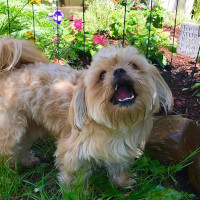Appearance of the Yorkinese
|
| The Yorkinese averages just 20.5 centimeters in height and weighs around 4.5 kilos, but at least some of this weight can be attributed to the fluffy, almost shell-like fur that surrounds it. Relative to its overall size, this breed has a considerable amount of hair that often masks, if not becomes, its features and comes in a variety of colors. It generally has a semi-square head shape with a short, black nose, bright, marbled eyes and an exaggerated moustache and forehead that look a little like a lion's when combined with folded or arched ears. Although small in stature, their posture exudes power thanks to slightly more muscular forelegs, but they generally retain a regular topline that ends in a medium-length, often bushy tail. |
Temperament of the Yorkinese
|
| Both independent and affectionate, Yorkinese are fantastic watchdogs, unfailingly loyal to their masters, but their stubborn attitude tends to present a few drawbacks. They can be notoriously stubborn and therefore difficult to train, sometimes even developing small dog syndrome, unless their owners quickly establish themselves as the alphas of the family. These types of behaviors are also more likely to make them excessively noisy, which can be a problem in close quarters. They cope modestly with children and other dogs, but generally prefer small families where they can be the center of attention. More than anything, if an owner takes the time to educate and socialize them early on, Yorkinese are intelligent enough to far exceed behavioral expectations and, with the right affection and attention, can make excellent pets in a variety of situations. |
Needs and activities of the Yorkinese
|
| Because of their small size, Yorkinese need only a small to moderate amount of exercise, and are generally content with a good walk and a little extra playtime every day. Interactive and brain-teasing games will also help to tire them out and discourage any unwanted behavior, especially if they take their role as watchdog too seriously. Around 10 km of walking a week and 20 to 30 minutes a day should be enough to keep him happy and healthy. |
Maintenance of the Yorkinese
|
| Because of the cloud of hair that regularly surrounds it, the Yorkinese is definitely a high-maintenance breed that requires daily brushing to avoid knots and tangles. A variety of brushes can be used, depending on length and coat layer, but owners should beware of hair breakage due to frequent or overly rigorous brushing. If this happens, consider using a light conditioner as a preparatory agent to make combing and brushing easier for both parties, it can also be used between brushings and baths to help maintain overall coat health. They should also be bathed between once and twice a month, depending on the length of their coat and the activities they take part in; those who regularly exercise outdoors or with other dogs will need more frequent baths for obvious reasons. Ears are another important maintenance point, as even prone ears - and many are more prone - are prone to bacterial build-up and infection if surrounded by too much hair, and need to be trimmed and monitored regularly. The eyes need to be similarly monitored and wiped to avoid tear stains, and the eye area needs to be trimmed fairly neatly to give them a good line of vision. As with many other small breeds, tooth care is another important point, as brachycephalic dogs and related crossbreeds are more prone to dental problems. As with any other breed, nails also need to be monitored and trimmed as required. |










 English (United Kingdom)
English (United Kingdom)